
HONEY PRODUCTION -AN ECONOMIC BOOST FOR POOR FARMING FAMILIES
EMWA have been working alongside beekeepers in the Nkwanta Oti Region since 2008. Our hands on approach to beekeeper training has proven to be very successful. Nkwanta has become one of the leading suppliers of honey to customers in Accra and other parts of Ghana . See successful project
Working closely with local beekeepers in Nkwanta has taught us many valuable lessons. The knowledge we’ve gained over the years can be of great benefit to beekeepers in other areas. Our initial goal of introducing Langstroth commercial beehives to Ghana is still our main focus. However over the past few years we’ve taken a step in a direction that might better suit the income of poorer farmers. Setup costs for Langstroth beekeeping is costly, although not prohibitive if taken in progressive steps. An idea that we’ve taken from one of the better beekeeping businesses here in Nkwanta is what has become called the KenLa hive. The KenLa hive retains the Langstroth beehive body design but instead of having 10 pre-wired rectangular shaped Langstroth frames that use beeswax foundation base, the new design uses 10 Kenya frames, which are a single molded frame that runs the length of the Langstroth hive body. (see pictures below)
*There are no milk producing goats that we know of in Ghana.

AFRAM PLAINS
KenLa Pilot Project
“We hope to replicate our Oti Region successes right across the Volta Lake in Afram Plains.”
Progress to date. The project began with the felling of Mahogany and Sanya trees on the farm of Alaji David Sunkwah, Next step was to cut them into planks and transport the planks to the mill for processing into boards before assembling them into Langstroth beehive bodies. The beehives will consist of full-depth brood boxes and the honey supers will be medium size. After the hives were assembled they were loaded into a trotro and transported past Kpando to the lakeside. There they were loaded onto a small motorized canoe. It was a one hour journey across the lake and another hour to the Cashew plantation where the hives were distributed throughout the plantation. Amazingly enough there must have been a swarm of bees waiting for this project to begin, because the very next day we went back to the hives to inspect them and found one hive already colonized. Thank you Jesus.
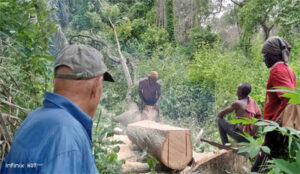
FELLED MAHOGANY TREE BEING CUT INTO PLANKS
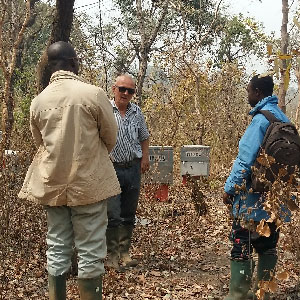
Stephen Williams
Project manager
Commercial Beekeeper, Queensland Australia.
“EMWA does not encourage free handouts. Credit repayment schemes are being researched through other successful beekeeping projects in Africa. Repayment in kind, for example is virtually inflation proof. This approach was very successful in our beekeeping project and was accomplished without having bank accounts or complicated book keeping.”
PHOTO 1. Sawing tree trunk into planks PHOTO 2. Project manager and Mr. Sankwah inspecting sawn planks PHOTO 3. Carpenter assembling hive bodies PHOTO 4. NGO staff member double checking hive body dimensions PHOTO 5. Hives at lakeside PHOTO 6. Loaded an on the way across Volta Lake PHOTO 7. Hives in Afram Plains and on their way to the farm PHOTO 8. Placed carefully in tree waiting for swarm. The hive was colonized the very next morning!

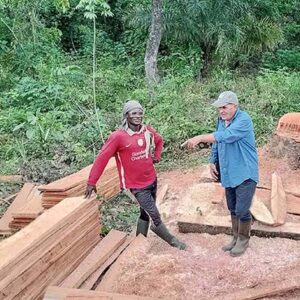
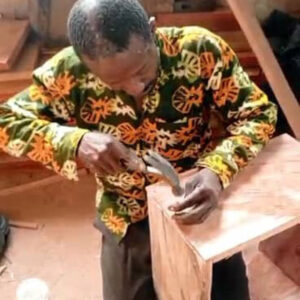

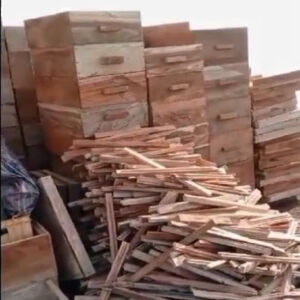
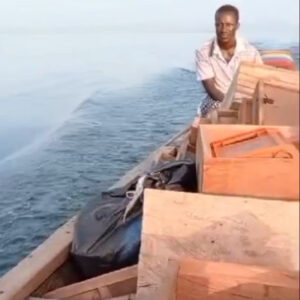
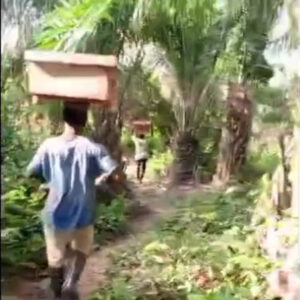
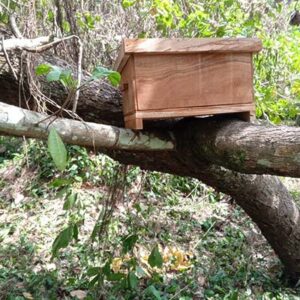
Featured Video
VIDEO 1: A short clip of how this pilot project began and the beehives journey across Volta Lake to Afram Plains.
VIDEO 2: Coming soon